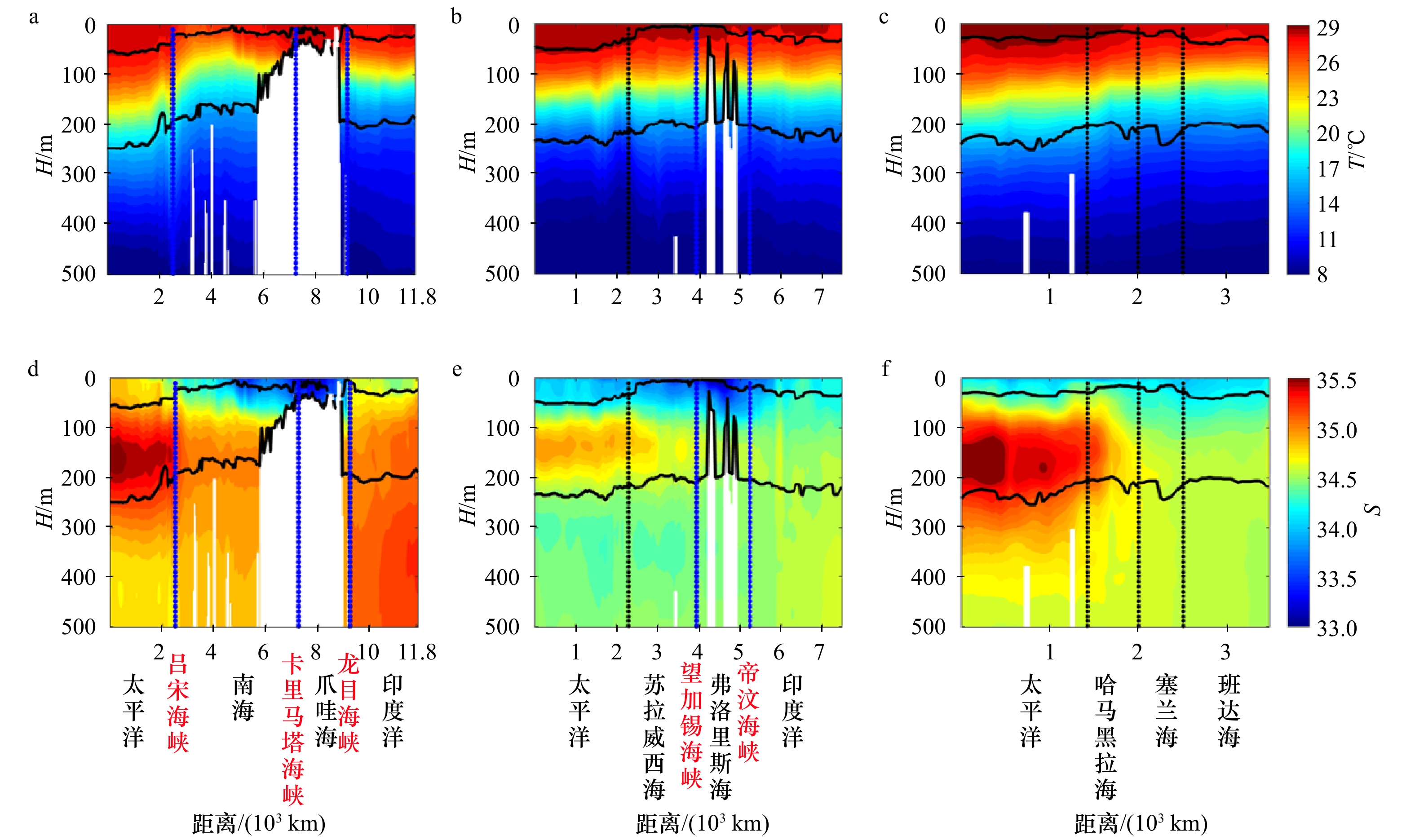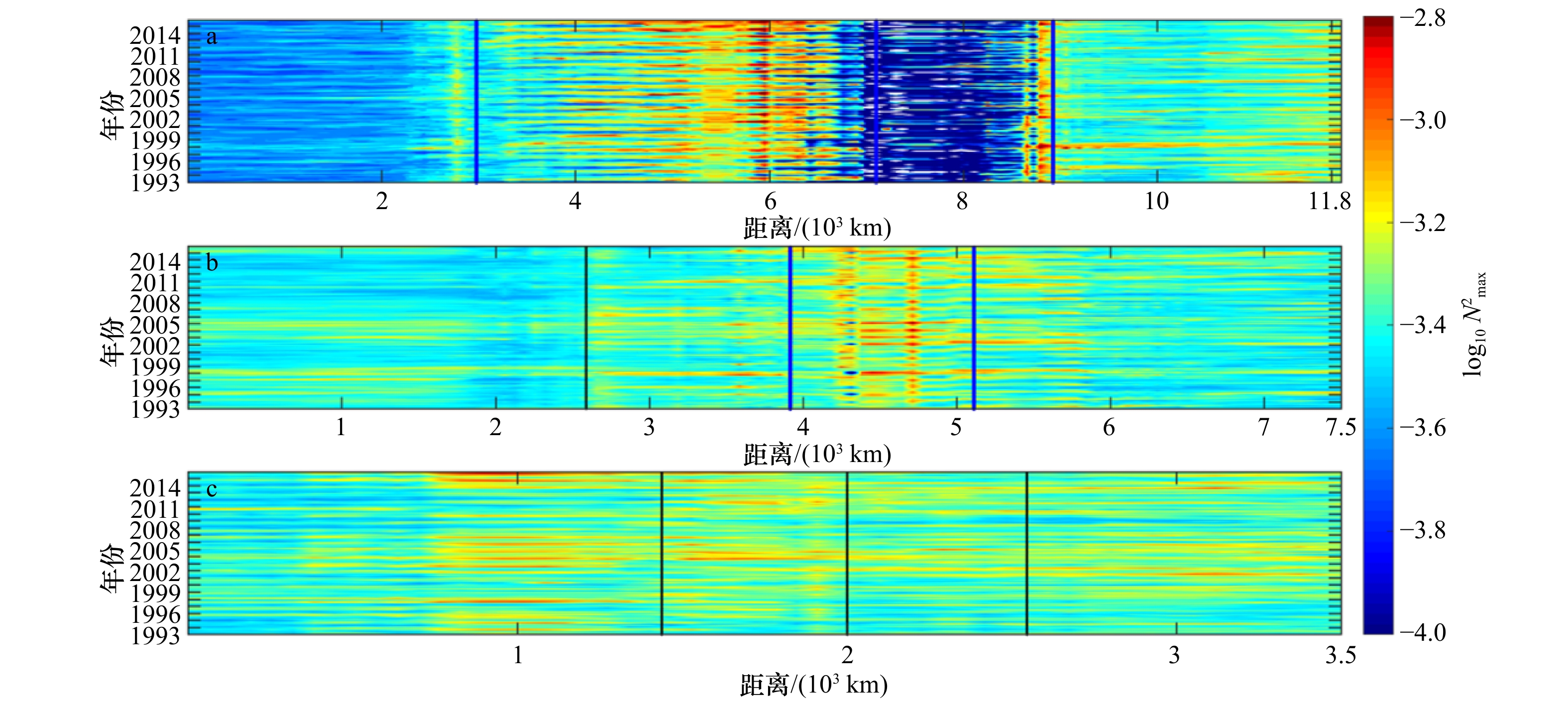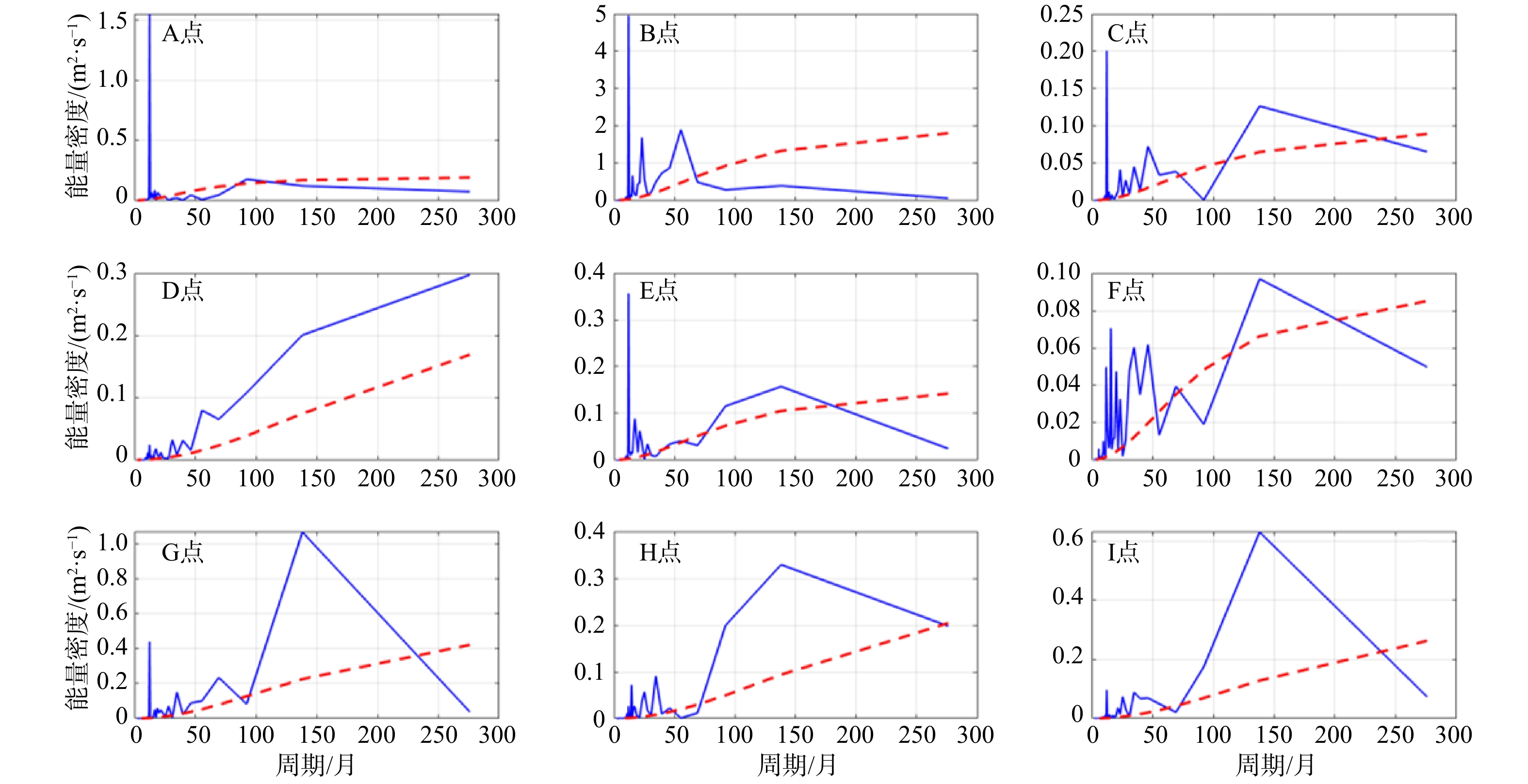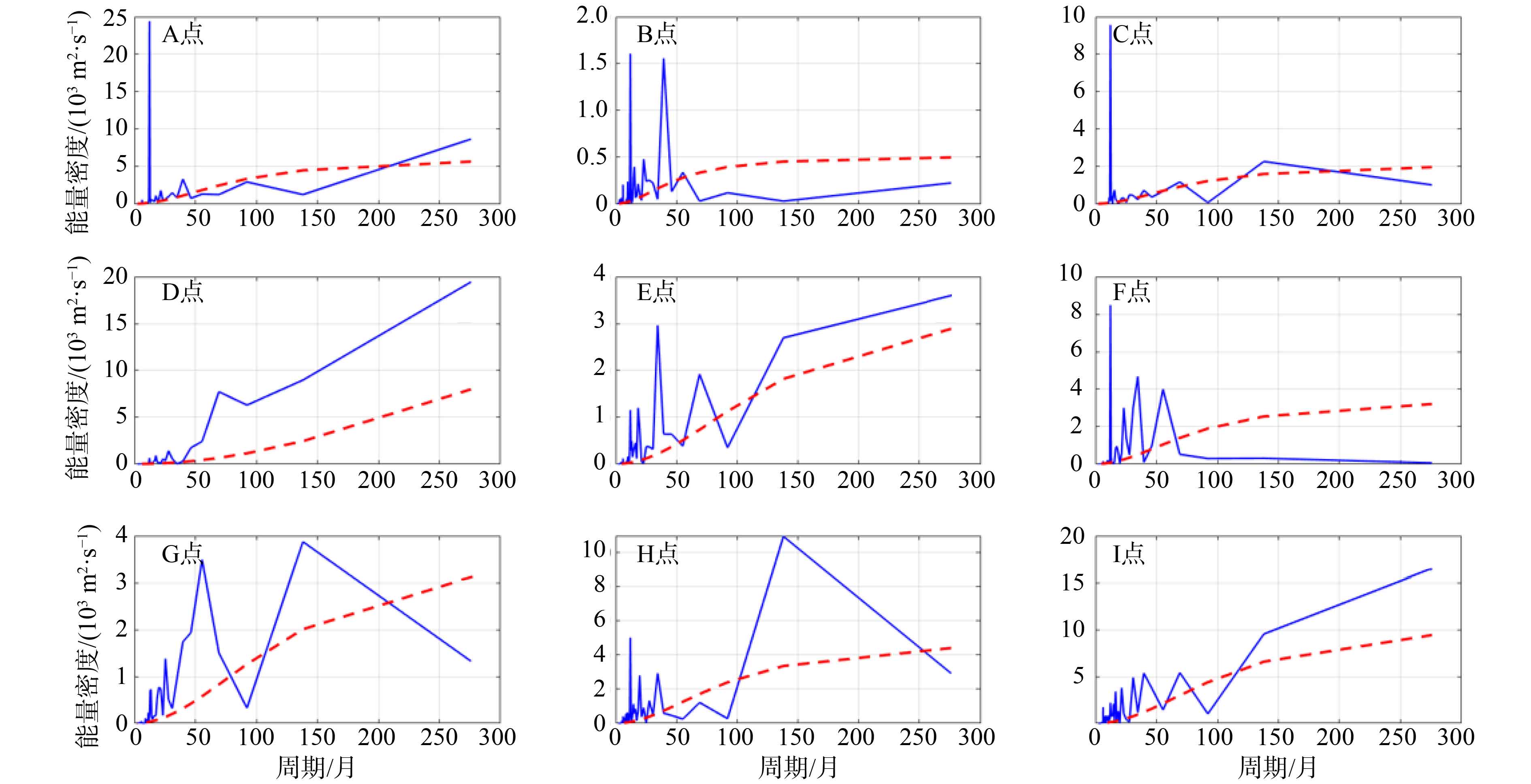Analysis of the spatiotemporal characteristics of stratification in the Indonesian seas and surrounding waters
-
摘要: 本文利用World Ocean Atlas 2013 (WOA13)和Simple Ocean Data Assimilation version 3.1.1 (SODA v3.3.1)温盐资料,分析印尼贯穿流(ITF)路径及所经印度尼西亚海及周边西太平洋、南海和东印度洋海域的层结强度(N2)和跃层特征的三维时空变化特征。结果表明,气候态下ITF 3条路径上跃层平均N2差异较小,其中中部路径平均值最大,为10−3.68 s−2,东部路径平均值最小,为10−3.71 s−2;各路径跃层深度和厚度存在明显差异,东部路径跃层深度和厚度最大,分别为124 m和192 m,中部次之,西部最小为99 m和143 m,并且印尼海的跃层深度和厚度平均值均小于其他海域。印尼海N2存在显著的季节变化和4~7 a的多年周期变化,其中年际变化可能主要受厄尔尼诺−南方涛动事件影响。季节上,在印尼海域内,ITF 3条路径夏季层结强度均小于冬季(北半球夏冬季),夏、冬两季N2差值最大可达到两个量级。1993−2015年的长期变化趋势显示,印尼海及周边大部分海域的层结强度呈现增强趋势,其中印度洋中部和哈马黑拉海23 a内最大层结增强近0.1个量级。Abstract: Using climatological and monthly temperature and salinity data from the World Ocean Atlas 2013 (WOA13) and the Simple Ocean Data Assimilation Version 3.3.1 (SODA v3.3.1), this study analyzes the 3D spatiotemporal characteristics of stratification (N2) and pycnocline along the pathways of Indonesia Throughflow (ITF) in the Indonesian seas and surrounding waters in the western Pacific, the South China Sea and the eastern Indian Ocean. The results show that the climatologically mean N2 in pycnocline has little difference in all the pathways of the ITF, and the largest value is 10−3.68 s−2 in the central pathway and the smallest is 10−3.71 s−2 in the eastern pathway. The differences are significant for the depth (Dpyc) and thickness (Hpyc) of the pycnocline along three pathways. The largest values of Dpyc and Hpyc are 124 m and 192 m in the eastern pathway, respectively, followed by values of 99 m and 143 m in the central pathway. Compared to the surrounding oceans, the mean pycnocline depth and thickness of the three pathways in the Indonesian seas are smaller than those in other seas. N2 and Dpyc have remarkably seasonal variation with period of one year and inter-annual variability with periods of 4−7 year cycles. The interannual variability may be mainly affected by the ENSO event. Seasonally, the summer N2 in the Indonesia seas is less than that in winter (northern hemisphere winter and summer), and the maximum difference between winter and summer can reach two orders of magnitude. The long-term variation trend of N2 from 1993 to 2015 shows that the stratification intensifies in most areas of Indonesian seas and surrounding waters, where N2 strengthened by nearly 0.1 order of magnitude in 23 years in the middle of the India Ocean and Halmahera Sea.
-
Key words:
- Indonesian seas /
- buoyancy frequency /
- pycnocline /
- Indonesia Throughflow /
- ENSO events
-
图 2 印尼海及周边海域气候态流场分布
a. 25 m深度流场;b. 150 m深度流场;黄、红、粉曲线分别为TIF西部路径、中部路径和东部路径
Fig. 2 2D distribution (x−y) of climatological velocities in the Indonesian seas and surrounding waters
a. Velocities at 25 m depth; b. velocities at 150 m depth; yellow, red, and pink lines represent the western, central, and eastern pathways of the ITF, respectively
图 3 ITF路径上气候态温度(a−c)和盐度(d−f)断面分布
a, d. 西部路径;b, e. 中部路径;c, f. 东部路径。蓝色虚线为海峡位置,黑色实线为跃层上下边界深度
Fig. 3 Distribution of climatological temperature(a−c)and salinity (d−f) along ITF pathways
a, d. The western pathway; b, e. the central pathway; c, f. the eastern pathway. Blue dashed lines represent the key straits, black solid lines represent the upper and the lower boundaries of the pycnocline
图 4 ITF路径上气候态浮力频率(N2)断面分布(N2的单位:s−2)
a. 西部路径;b. 中部路径;c. 东部路径。蓝色虚线为海峡位置,黑色实线为跃层上下边界深度
Fig. 4 Distribution of climatological squared buoyancy frequency (N2) along ITF pathways (unit of N2 is s−2)
a. The western pathway; b. the central pathway; c. the eastern pathway. Blue dashed lines represent the key straits, black solid lines represent the upper and the lower boundaries of the pycnocline
图 5 印尼海及周围海域气候态层结特征平面分布
a. 最大浮力频率N2max;b. 最大浮力频率所在深度${D_{N_{{\rm{max}}}^2}}$;c. 跃层内平均浮力频率${\overline{{N}^{2}}}$;d. 密度跃层平均深度Dpcline
Fig. 5 2D distribution (x-y) of climatological stratification characteristics in the Indonesian seas and surrounding waters
a. The maximum squared buoyancy frequency ${N_{{{\rm{max}}}}^2}$; b. the depth of the maximum squared buoyancy frequency ${D_{N_{{\rm{max}}}^2}}$; c. the mean squared buoyancy frequency in pycnocline ${\overline{{N}^{2}}}$; d. the average depth of pycnocline Dpcline
图 6 ITF路径上夏、冬季浮力频率(N2)断面
a、b、c分别示出TIF西部路径夏、冬季浮力频率以及夏冬浮力频率之差(ΔN2);d、e、f为中部路径;g、h、i为东部路径
Fig. 6 Distribution of summer and winter squared buoyancy frequencies (N2) along ITF pathways
a, b, and c are the squared buoyancy frequency in summer, winter and the summer-winter difference (ΔN2) along the western ITF pathway, respectively; d, e, and f are that of the central pathway; g, h, and i are that along eastern pathway
图 7 印尼海及周围海域夏冬季最大浮力频率(N2max)和最大层结深度
$D_{N_{{\rm{max}}}^2}$ 的平面分布a、b、c分别示出夏、冬季最大浮力频率(N2max)以及夏冬之差(ΔN2max);d、e、f分别示出夏、冬季最大层结深度($D_{N_{{\rm{max}}}^2} $)以及夏冬之差(Δ$D_{N_{{\rm{max}}}^2}$)
Fig. 7 2D distribution (x-y) of maximum squared buoyancy frequency (N2max) and maximum stratigraphic depth (
$D_{N_{{\rm{max}}}^2}$ ) in summer and winter in the Indonesia seas and surrounding watersa, b, and c are the squared maximum buoyancy frequency (N2max) in summer, winter and the summer-winter difference (ΔN2max), respectively; d, e, and f are the depth of the maximum squared buoyancy frequency ($D_{N_{{\rm{max}}}^2} $) in summer, winter and the summer-winter difference (Δ$D_{N_{{\rm{max}}}^2} $),respectively
图 9 图1中A−I点1993−2015年N2max变化趋势
黑线为N2max距平值,红线为多年变化趋势;*表示通过95%置信度检验,**表示通过99%置信度检验
Fig. 9 Variation of the maximum squared buoyancy frequency (N2max) at points A−I marked in Fig. 1 from 1993 to 2015
Black lines represent the N2max anomaly, red lines represent multi-year trends; the * mark indicating passing the 95% confidence test, and ** passing the 99% confidence test
表 1 ITF路径平均跃层强度、深度和厚度
Tab. 1 Mean
$ {{N}}^{2} $ , depth and thickness of pycnocline along ITF pathways跃层平均强度log10N2 跃层深度Hpyc/m 跃层厚度Dpyc/m 西部 中部 东部 西部 中部 东部 西部 中部 东部 太平洋 −3.78 −3.68 −3.72 142 139 131 180 185 202 南海 −3.64 − − 79 − − 126 − − 印尼海区 −3.86 −3.66 −3.71 45 100 118 57 179 185 印度洋 −3.64 −3.70 − 112 123 − 127 191 − 平均±偏差 −3.70±0.13 −3.68±0.04 −3.71±0.02 99±55 120±27 124±9 143±38 185±22 192±18 注:−表示无数据。 -
[1] 王永刚, 魏泽勋, 方国洪, 等. 印度尼西亚海域潮波的数值研究[J]. 海洋学报, 2014, 36(3): 1−8.Wang Yonggang, Wei Zexun, Fang Guohong, et al. Numerical study of tides in the Indonesia seas[J]. Haiyang Xuebao, 2014, 36(3): 1−8. [2] 王健, 杜岩, 郑少军, 等. 2004−2011年印度尼西亚贯穿流在望加锡海峡中的年际变化[J]. 热带海洋学报, 2014, 33(6): 9−16. doi: 10.3969/j.issn.1009-5470.2014.06.002Wang Jian, Du Yan, Zheng Shaojun, et al. Interannual variability of Indonesian Throughflow in the Makassar Strait during 2004−2011[J]. Journal of Tropical Oceanography, 2014, 33(6): 9−16. doi: 10.3969/j.issn.1009-5470.2014.06.002 [3] 杨阳, 周伟东, 董丹鹏. 印尼贯穿流的诊断计算[J]. 热带海洋学报, 2007, 26(2): 1−8. doi: 10.3969/j.issn.1009-5470.2007.02.001Yang Yang, Zhou Weidong, Dong Danpeng. Diagnostic calculation of Indonesian Throughflow[J]. Journal of Tropical Oceanography, 2007, 26(2): 1−8. doi: 10.3969/j.issn.1009-5470.2007.02.001 [4] Hirst A C, Godfrey J S. The role of Indonesian Throughflow in a global ocean GCM[J]. Journal of Physical Oceanography, 1993, 23(6): 1057−1086. doi: 10.1175/1520-0485(1993)023<1057:TROITI>2.0.CO;2 [5] Clarke A J, Liu Xiano. Observations and dynamics of semiannual and annual sea levels near the eastern equatorial Indian Ocean boundary[J]. Journal of Physical Oceanography, 1993, 23(2): 386−399. doi: 10.1175/1520-0485(1993)023<0386:OADOSA>2.0.CO;2 [6] Wijffes S, Meyers G. An intersection of oceanic waveguides: Variability in the Indonesian Throughflow region[J]. Journal of Physical Oceanography, 2004, 34(5): 1232−1253. doi: 10.1175/1520-0485(2004)034<1232:AIOOWV>2.0.CO;2 [7] 张晶, 魏泽勋, 李淑江, 等. 太平洋−印度洋贯穿流南海分支研究综述[J]. 海洋科学进展, 2014, 32(1): 107−120. doi: 10.3969/j.issn.1671-6647.2014.01.013Zhang Jing, Wei Zexun, Li Shujiang, et al. Overviews on studies of the South China Sea branch of the Pacific-Indian ocean throughflow[J]. Advances in Marine Science, 2014, 32(1): 107−120. doi: 10.3969/j.issn.1671-6647.2014.01.013 [8] 徐腾飞, 周慧. 海洋再分析资料中IOD-ENSO遥相关的海洋通道机制分析[J]. 海洋学报, 2016, 38(12): 23−35.Xu Tengfei, Zhou Hui. Oceanic channel dynamics of the IOD-ENSO teleconnection in oceanic reanalysis datasets[J]. Haiyang Xuebao, 2016, 38(12): 23−35. [9] Cronin M F, Bond N A, Farrar J T, et al. Formation and erosion of the seasonal thermocline in the Kuroshio Extension recirculation gyre[J]. Deep-Sea Research Part II: Topical Studies in Oceanography, 2013, 85: 62−74. doi: 10.1016/j.dsr2.2012.07.018 [10] Qiu Bo, Chen Shuiming, Hacker P. Synoptic-scale air sea flux forcing in the western North Pacific: Observations and their impact on SST and the mixed layer[J]. Journal of Physical Oceanography, 2004, 34(10): 2148−2159. doi: 10.1175/1520-0485(2004)034<2148:SAFFIT>2.0.CO;2 [11] 马云瑞, 郭佩芳. 我国深远水养殖环境适宜条件研究[J]. 海洋环境科学, 2017, 36(2): 249−254.Ma Yunrui, Guo Peifang. The research of suitable conditions for Chinese mariculture environment in deep-water area far from coast[J]. Marine Environmental Science, 2017, 36(2): 249−254. [12] Qu Tangdong, Du Yan, Meyers G, et al. Connecting the tropical Pacific with Indian Ocean through South China Sea[J]. Geophysical Research Letters, 2005, 32(24): L24609. doi: 10.1029/2005GL024698 [13] Tozuka T, Qu Tangdong, Masumoto Y, et al. Impacts of the South China Sea throughflow on seasonal and interannual variations of the Indonesian Throughflow[J]. Dynamics of Atmospheres and Oceans, 2009, 47(1/3): 73−85. [14] Susanto R D, Fang Guohong, Soesilo I, et al. New surveys of a branch of the Indonesian Throughflow[J]. Eos, Transactions American Geophysical Union, 2010, 91(30): 261−263. [15] Susanto R D, Wei Zexun, Adi R T, et al. Observations of the Karimata Strait Througflow from December 2007 to November 2008[J]. Acta Oceanologica Sinica, 2013, 32(5): 1−6. doi: 10.1007/s13131-013-0307-3 [16] Wajsowicz, Roxana C. Flow of a western boundary current through multiple straits: An electrical circuit analogy for the Indonesian Throughflow and archipelago[J]. Journal of Geophysical Research Atmospheres, 1996, 101(C5): 12295−12300. doi: 10.1029/95JC02615 [17] Gordon A L, Sprintall J, Van Aken H M, et al. The Indonesian Throughflow during 2004–2006 as observed by the INSTANT program[J]. Dynamics of Atmospheres and Oceans, 2010, 50(2): 115−128. doi: 10.1016/j.dynatmoce.2009.12.002 [18] Susanto R D, Ffield A, Gordon A L, et al. Variability of Indonesian Throughflow within Makassar Strait, 2004–2009[J]. Journal of Geophysical Research: Oceans, 2012, 117(C9): C09013. [19] Luick J L, Cresswell G R. Current measurements in the Maluku Sea[J]. Journal of Geophysical Research: Oceans, 2001, 106(C7): 13953−13958. doi: 10.1029/2000JC000694 [20] Van Aken H M, Brodjonegoro I S, Jaya I. The deep-water motion through the Lifamatola Passage and its contribution to the Indonesian Throughflow[J]. Deep-Sea Research Part I: Oceanographic Research Papers, 2009, 56(8): 1203−1216. doi: 10.1016/j.dsr.2009.02.001 [21] 杜岩, 方国洪. 印度尼西亚海与印度尼西亚贯穿流研究概述[J]. 地球科学进展, 2011, 26(11): 1131−1142.Du Yan, Fang Guohong. Progress on the study of the Indonesian Seas and Indonesian Throughflow[J]. Advances in Earth Science, 2011, 26(11): 1131−1142. [22] 曹国娇, 魏泽勋, 徐腾飞, 等. 印度尼西亚贯穿流及其周边海域季节内变化研究综述[J]. 海洋科学, 2015, 39(10): 125−133. doi: 10.11759/hykx20141211001Cao Guojiao, Wei Zexun, Xu Tengfei, et al. Progress on the study of oceanic intraseasonal variability in the Indonesian Throughflow and its adjacent regions[J]. Marine Sciences, 2015, 39(10): 125−133. doi: 10.11759/hykx20141211001 [23] Meyers G, Bailey R J, Worby A P. Geostrophic transport of Indonesian Throughflow[J]. Deep-Sea Research Part I: Oceanographic Research Papers, 1995, 42(7): 1163−1174. doi: 10.1016/0967-0637(95)00037-7 [24] England M H, Huang Fei. On the interannual variability of the Indonesian Throughflow and its linkage with ENSO[J]. Journal of Climate, 2005, 18(9): 1435−1444. doi: 10.1175/JCLI3322.1 [25] Susanto R D, Gordon A L. Velocity and transport of the Makassar Strait Throughflow[J]. Journal of Geophysical Research: Oceans, 2005, 110(C1): C01005. [26] Yuan Dongliang, Wang Jing, Xu Tengfei, et al. Forcing of the Indian Ocean dipole on the interannual variations of the tropical Pacific Ocean: Roles of the Indonesian Throughflow[J]. Journal of Climate, 2011, 24(14): 3593−3608. doi: 10.1175/2011JCLI3649.1 [27] Robertson R, Ffield A. Baroclinic tides in the Indonesian Seas: Tidal fields and comparisons to observations[J]. Journal of Geophysical Research: Oceans, 2008, 113(C7): C07031. [28] Robertson R. Interactions between tides and other frequencies in the Indonesian Seas[J]. Ocean Dynamics, 2011, 61(1): 69−88. doi: 10.1007/s10236-010-0343-x [29] Ray R D, Egbert G D, Erofeeva S Y. A brief overview of tides in the Indonesian Seas[J]. Oceanography, 2005, 18(4): 74−79. doi: 10.5670/oceanog.2005.07 [30] Schiller A, Fiedler R. Explicit tidal forcing in an ocean general circulation model[J]. Geophysical Research Letters, 2007, 34(3): L03611. [31] Robertson R, Ffield A. M2 baroclinic tides in the Indonesian Seas[J]. Oceanography, 2005, 18(4): 62−73. doi: 10.5670/oceanog.2005.06 [32] Nof D. Choked flows from the Pacific to the Indian Ocean[J]. Journal of Physical Oceanography, 1995, 25(6): 1369−1383. doi: 10.1175/1520-0485(1995)025<1369:CFFTPT>2.0.CO;2 [33] Gordon A L, Fine R A. Pathways of water between the Pacific and Indian oceans in the Indonesian Seas[J]. Nature, 1996, 379(6561): 146−149. doi: 10.1038/379146a0 [34] 张艳慧, 于晓林, 王凡. 基于历史资料和Argo资料的印尼贯通流次表层和中层水起源与路径探讨[J]. 海洋学报, 2008, 30(3): 1−8.Zhang Yanhui, Yu Xiaolin, Wang Fan. Origins and pathways of the subsurface and intermediate waters of Indonesian Throughflow derived from historical and Argo data[J]. Haiyang Xuebao, 2008, 30(3): 1−8. [35] Wang Lu, Zhou Lei, Xie Lingling, et al. Seasonal and interannual variability of water mass sources of Indonesian Throughflow in the Maluku Sea and the Halmahera Sea[J]. Acta Oceanologica Sinica, 2019, 38(4): 58−71. doi: 10.1007/s13131-019-1413-7 [36] 刘桂芳. 1987年7月粤东陆架区温、盐、密度跃层的分布特征[J]. 热带海洋, 1989(2): 39−47.Liu Guifang. Distribution characteristics of temperature, salinity and density in the continental shelf off east Guangdong during July 1987[J]. Journal of Tropical Oceanography, 1989(2): 39−47. [37] 张绪东, 佟凯, 尼建军, 等. 台湾周边海域密度跃层分析[J]. 海洋预报, 2004, 21(4): 16−27. doi: 10.3969/j.issn.1003-0239.2004.04.003Zhang Xudong, Tong Kai, Ni Jianjun, et al. The anylysis about the density spring-layers around Taiwan sea[J]. Marine Forecasts, 2004, 21(4): 16−27. doi: 10.3969/j.issn.1003-0239.2004.04.003 [38] 刘金芳, 毛可修, 张晓娟, 等. 中国海密度跃层分布特征概况[J]. 海洋预报, 2013, 30(6): 21−27. doi: 10.11737/j.issn.1003-0239.2013.06.004Liu Jinfang, Mao Kexiu, Zhang Xiaojuan, et al. The general distribution characteristics of pycnocline of China sea[J]. Marine Forecasts, 2013, 30(6): 21−27. doi: 10.11737/j.issn.1003-0239.2013.06.004 [39] 廖光洪, 黄韦艮, 袁耀初, 等. veKdv方程的若干系数在南海北部的地理分布特征及其季节变化分析[J]. 海洋学报, 2013, 35(5): 46−58.Liao Guanghong, Huang Weigen, Yuan Yaochu, et al. Analysis of geographical and seasonal variability of the variable-coefficients extended Korteweg-de Vries equation in the northern South China Sea[J]. Haiyang Xuebao, 2013, 35(5): 46−58. [40] 郑曼立, 李明明, 谢玲玲, 等. 2012年南海西北陆架冬季水文特征的观测分析[J]. 海洋与湖沼, 2018, 49(4): 734−745.Zheng Manli, Li Mingming, Xie Lingling, et al. Observation of hydrographic characteristics of northwestern shelf of the South China Sea in winter 2012[J]. Oceanologia et Limnologia Sinica, 2018, 49(4): 734−745. [41] 袁瑞, 王统泽, 张洪生. 南海北部海洋分层对厄尔尼诺和拉尼娜事件的响应[C]//第十九届中国海洋(岸)工程学术讨论会论文集(上). 北京: 海洋出版社, 2019.Yuan Rui, Wang Tongze, Zhang Hongsheng. Response of the northern ocean stratification of the South China Sea to El Niño and La Niña events[C]//The 19th China Ocean (Shore) Engineering Symposium. Beijing: China Ocean Press, 2019. [42] Emery W J, Lee W G, Magaard L. Geographic and seasonal distributions of brunt–vaisala frequency and rossby radii in the North Pacific and North Atlantic[J]. Journal of Physical Oceanography, 1984, 14(2): 294−317. doi: 10.1175/1520-0485(1984)014<0294:GASDOB>2.0.CO;2 [43] 蒲书箴, 于卫东, 程军. 热带西太平洋浮力频率的垂直分布和经向变化[J]. 海洋科学进展, 2004, 22(3): 275−283. doi: 10.3969/j.issn.1671-6647.2004.03.003Pu Shuzhen, Yu Weidong, Cheng Jun. Longitudinal variabilities and vertical distributions of buoyancy frequency in the western tropical Pacific Ocean[J]. Advances in Marine Science, 2004, 22(3): 275−283. doi: 10.3969/j.issn.1671-6647.2004.03.003 [44] 江伟, 李培, 高文洋, 等. 西北太平洋密度跃层特征分析[J]. 海洋预报, 2010, 27(2): 15−21. doi: 10.3969/j.issn.1003-0239.2010.02.003Jiang Wei, Li Pei, Gao Wenyang, et al. Pycnocline analysis on the Northwest Pacific Ocean[J]. Marine Forecasts, 2010, 27(2): 15−21. doi: 10.3969/j.issn.1003-0239.2010.02.003 [45] Yamaguchi R, Suga T. Trend and variability in global upper-ocean stratification since the 1960s[J]. Journal of Geophysical Research: Oceans, 2019, 124(12): 8933−8948. doi: 10.1029/2019JC015439 [46] 王露. 印尼贯穿流源区马鲁古海和哈马黑拉海的水团来源分析[D]. 湛江: 广东海洋大学, 2018.Wang Lu. Analysis of water mass sources of Indonesia Throughflow in the Maluku and the Halmahera seas[D]. Zhanjiang: Guangdong Ocean University, 2018. [47] 王露, 谢玲玲, 周磊, 等. 印尼贯穿流源区马鲁古海和哈马黑拉海水团来源的气候态分析[J]. 海洋学报, 2018, 40(3): 1−15.Wang Lu, Xie Lingling, Zhou Lei, et al. Climatological analysis of water mass sources of Indonesia Throughflow in the Molukka Sea and Halmahera Sea[J]. Haiyang Xuebao, 2018, 40(3): 1−15. [48] Huang Zhida, Zhuang Wei, Liu Hailong, et al. Subduction of a low-salinity water mass around the Xisha Islands in the South China Sea[J]. Scientific Reports, 2018, 8(1): 3074. doi: 10.1038/s41598-018-21364-3 [49] Li Changjun, Zhao Hong, Li Hongping, et al. Assessment of SMOS and Aquarius/SAC-D salinity data accuracy in the South China Sea: Three statistical methods[C]//IEEE International Geoscience and Remote Sensing Symposium (IGARSS). Milan, Italy: IEEE, 2015. [50] Kumar P K D, Paul Y S, Muraleedharan K R, et al. Comparison of long-term variability of sea surface temperature in the Arabian Sea and Bay of Bengal[J]. Regional Studies in Marine Science, 2016, 3: 67−75. doi: 10.1016/j.rsma.2015.05.004 [51] Carton J A, Chepurin G A, Chen Ligang. SODA3: A new ocean climate reanalysis[J]. Journal of Climate, 2018, 31(17): 6967−6983. doi: 10.1175/JCLI-D-18-0149.1 [52] Sprintall J, Wijffels S E, Molcard R, et al. Direct estimates of the Indonesian Throughflow entering the Indian Ocean: 2004–2006[J]. Journal of Geophysical Research: Oceans, 2009, 114(C7): C07001. [53] Wyrtki K. Scientific results of marine investigations of the South China Sea and the Gulf of Thailand 1959−1961[J]. Naga Report, 1961, 2(4): 677−684. [54] Metzger E J, Hurlburt H E. The importance of high horizontal resolution and accurate coastline geometry in modeling South China Sea inflow[J]. Geophysical Research Letters, 2001, 28(6): 1059−1062. doi: 10.1029/2000GL012396 [55] 方国洪, 魏泽勋, 黄企洲, 等. 南海南部与外海间的体积和热、盐输运及其对印尼贯穿流的贡献[J]. 海洋与湖沼, 2002, 33(3): 296−302. doi: 10.3321/j.issn:0029-814X.2002.03.010Fang Guohong, Wei Zexun, Huang Qizhou, et al. Volume, heat and salt transports between the southern South China Sea and its adjacent waters, and their contribution to the Indonesian Throughflow[J]. Oceanologia et Limnologia Sinica, 2002, 33(3): 296−302. doi: 10.3321/j.issn:0029-814X.2002.03.010 [56] 方国洪, 魏泽勋, 崔秉昊, 等. 中国近海域际水、热、盐输运: 全球变网格模式结果[J]. 中国科学(D辑: 地球科学), 2002, 32(12): 969−977. doi: 10.3321/j.issn:1006-9267.2002.12.001Fang Guohong, Wei Zexun, Cui Binghao, et al. Interregional water, heat and salt transport in China's coastal waters: Results from a global variable grid model[J]. Science in China Series D: Earth Sciences, 2002, 32(12): 969−977. doi: 10.3321/j.issn:1006-9267.2002.12.001 [57] Lebedev K V, Yaremchuk M I. A diagnostic study of the Indonesian Throughflow[J]. Journal of Geophysical Research: Oceans, 2000, 105(C5): 11243−11258. doi: 10.1029/2000JC900015 [58] Fang Guohong, Susanto R D, Wirasantosa S, et al. Volume, heat, and freshwater transports from the South China Sea to Indonesian seas in the boreal winter of 2007–2008[J]. Journal of Geophysical Research: Oceans, 2010, 115(C12): C12020. doi: 10.1029/2010JC006225 [59] Qu Tangdong, Kim Y Y, Yaremchuk M, et al. Can luzon strait transport play a role in conveying the impact of ENSO to the South China Sea?[J]. Journal of Climate, 2004, 17(18): 3644−3657. doi: 10.1175/1520-0442(2004)017<3644:CLSTPA>2.0.CO;2 [60] Qu Tangdong, Du Yan, Sasaki H. South China Sea Throughflow: a heat and freshwater conveyor[J]. Geophysical Research Letters, 2006, 33(23): L23617. doi: 10.1029/2006GL028350 [61] Gordon A L. Oceanography of the Indonesian seas and their throughflow[J]. Oceanography, 2005, 18(4): 14−27. doi: 10.5670/oceanog.2005.01 [62] 冯士筰, 李凤岐, 李少菁. 海洋科学导论[M]. 北京: 高等教育出版社, 1999.Feng Shizuo, Li Fengqi, Li Shaojing. Introduction to Marine Science[M]. Beijing: Higher Education Press, 1999. [63] 吴巍, 方欣华, 吴德星. 关于跃层深度确定方法的探讨[J]. 海洋湖沼通报, 2001(2): 1−7. doi: 10.3969/j.issn.1003-6482.2001.02.001Wu Wei, Fang Xinhua, Wu Dexing. On the methods of determining the depthes of thermocline, halocline and pycnocline[J]. Transactions of Oceanology and Limnology, 2001(2): 1−7. doi: 10.3969/j.issn.1003-6482.2001.02.001 [64] Xie Lingling, Tian Jiwei, Hu Dunxin, et al. A quasi-synoptic interpretation of water mass distribution and circulation in the western North Pacific: I. Water mass distribution[J]. Chinese Journal of Oceanology and Limnology, 2009, 27(3): 630−639. doi: 10.1007/s00343-009-9161-8 [65] Hatayama T. Transformation of the Indonesian Throughflow water by vertical mixing and its relation to tidally generated internal waves[J]. Journal of Oceanography, 2004, 60(3): 569−585. doi: 10.1023/B:JOCE.0000038350.32155.cb [66] Sprintall J, Gordon A L, Koch-Larrouy A, et al. The Indonesian seas and their role in the coupled ocean-climate system[J]. Nature Geoscience, 2014, 7(7): 487−492. doi: 10.1038/ngeo2188 [67] Nagai T, Hibiya T. Internal tides and associated vertical mixing in the Indonesian Archipelago[J]. Journal of Geophysical Research Oceans, 2015, 120(5): 3373−3390. doi: 10.1002/2014JC010592 [68] Koch-Larrouy A, Madec G, Bouruet-Aubertot P, et al. On the transformation of Pacific water into Indonesian Throughflow water by internal tidal mixing[J]. Geophysical Research Letters, 2007, 34(4): L04604. [69] 刘谊, 王晓玮, 彭世球. 印度尼西亚海内潮生成及传播过程研究[J]. 热带海洋学报, 2018, 37(2): 1−9.Liu Yi, Wang Xiaowei, Peng Shiqiu. On the generation and propagation of internal tides in the Indonesian seas[J]. Journal of Tropical Oceanography, 2018, 37(2): 1−9. [70] Koch-Larrouy A, Lengaigne M, Terray P, et al. Tidal mixing in the Indonesian seas and its effect on the tropical climate system[J]. Climate Dynamics, 2010, 34(6): 891−904. doi: 10.1007/s00382-009-0642-4 [71] Kida S, Wijffels S. The impact of the Indonesian Throughflow and tidal mixing on the summertime sea surface temperature in the western Indonesian seas[J]. Journal of Geophysical Research: Oceans, 2012, 117(C9): C09007. [72] 翟丽, 方国洪, 王凯. 南海风生正压环流动力机制的数值研究[J]. 海洋与湖沼, 2004, 35(4): 289−298. doi: 10.3321/j.issn:0029-814X.2004.04.001Zhai Li, Fang Guohong, Wang Kai. Numerical study on the dynamics of wind driven barotropic circulation in the South China Sea[J]. Oceanologia et Limnologia Sinica, 2004, 35(4): 289−298. doi: 10.3321/j.issn:0029-814X.2004.04.001 [73] 魏泽勋, 方国洪, 崔秉昊, 等. 南海海面高度和输运流函数: 全球变网格模式结果[J]. 中国科学(D辑: 地球科学), 2003, 46(2): 139−148. doi: 10.3969/j.issn.1674-7240.2003.02.006Wei Zexun, Fang Guohong, Choi Binghao, et al. Sea surface height and transport stream function of the South China Sea from a variable-grid global ocean circulation model[J]. Science in China Series D: Earth Sciences, 2003, 46(2): 139−148. doi: 10.3969/j.issn.1674-7240.2003.02.006 [74] Wijffels S, Meyers G. An intersection of oceanic waveguides: Variability in the Indonesian Throughflow region[J]. Journal of Physical Oceanography, 2004, 34(5): 1988−1990. [75] Qu Tangdong, Gan Jianping, Ishida A, et al. Semiannual variation in the western tropical Pacific Ocean[J]. Geophysical Research Letters, 2008, 35(16): 134−143. [76] Meyers G. Variation of Indonesian Throughflow and the El Niño-Southern Oscillation[J]. Journal of Geophysical Research: Oceans, 1996, 101(C5): 12255−12263. doi: 10.1029/95JC03729 [77] Lee T, Fukumori I, Menemenlis D, et al. Effects of the Indonesian Throughflow on the Pacific and Indian oceans[J]. Journal of Physical Oceanography, 2002, 32(5): 1404−1429. doi: 10.1175/1520-0485(2002)032<1404:EOTITO>2.0.CO;2 [78] Song Qian, Vecchi G A, Rosati A J. The role of the Indonesian Throughflow in the Indo-Pacific climate variability in the GFDL coupled climate model[J]. Journal of Climate, 2007, 20(11): 2434−2451. doi: 10.1175/JCLI4133.1 [79] 吴海燕, 李崇银, 张铭. 印尼贯穿流对热带太平洋−印度洋海温异常综合模影响的初步模拟研究[J]. 热带气象学报, 2010, 26(5): 513−520. doi: 10.3969/j.issn.1004-4965.2010.05.001Wu Haiyan, Li Chongyin, Zhang Ming. The preliminary numerical research of effects of ITF on tropical Pacific-Indian ocean associated temperature anomaly mode[J]. Journal of Tropical Meteorology, 2010, 26(5): 513−520. doi: 10.3969/j.issn.1004-4965.2010.05.001 [80] Santoso A, Cai W, Englang M H, et al. The role of the Indonesian Throughflow on ENSO dynamics in a coupled climate model[J]. Journal of Climate, 2010, 24(3): 585−601. -





 下载:
下载:













